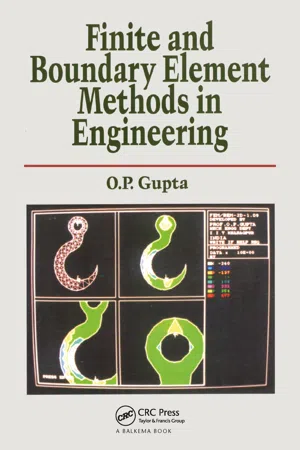
- 494 pages
- English
- ePUB (mobile friendly)
- Available on iOS & Android
eBook - ePub
Finite and Boundary Element Methods in Engineering
About this book
The interest in finite element method as a solution technique of the computer age is reflected in the availability of many general and special purpose software based on this technique. This work aims to provide a complete and detailed explanation of the basics of the application areas.
Frequently asked questions
Yes, you can cancel anytime from the Subscription tab in your account settings on the Perlego website. Your subscription will stay active until the end of your current billing period. Learn how to cancel your subscription.
At the moment all of our mobile-responsive ePub books are available to download via the app. Most of our PDFs are also available to download and we're working on making the final remaining ones downloadable now. Learn more here.
Perlego offers two plans: Essential and Complete
- Essential is ideal for learners and professionals who enjoy exploring a wide range of subjects. Access the Essential Library with 800,000+ trusted titles and best-sellers across business, personal growth, and the humanities. Includes unlimited reading time and Standard Read Aloud voice.
- Complete: Perfect for advanced learners and researchers needing full, unrestricted access. Unlock 1.4M+ books across hundreds of subjects, including academic and specialized titles. The Complete Plan also includes advanced features like Premium Read Aloud and Research Assistant.
We are an online textbook subscription service, where you can get access to an entire online library for less than the price of a single book per month. With over 1 million books across 1000+ topics, we’ve got you covered! Learn more here.
Look out for the read-aloud symbol on your next book to see if you can listen to it. The read-aloud tool reads text aloud for you, highlighting the text as it is being read. You can pause it, speed it up and slow it down. Learn more here.
Yes! You can use the Perlego app on both iOS or Android devices to read anytime, anywhere — even offline. Perfect for commutes or when you’re on the go.
Please note we cannot support devices running on iOS 13 and Android 7 or earlier. Learn more about using the app.
Please note we cannot support devices running on iOS 13 and Android 7 or earlier. Learn more about using the app.
Yes, you can access Finite and Boundary Element Methods in Engineering by O.P. Gupta in PDF and/or ePUB format, as well as other popular books in Technology & Engineering & Civil Engineering. We have over one million books available in our catalogue for you to explore.
Information
Chapter 1 INTRODUCTION AND BASIC CONCEPTS
DOI: 10.1201/9780203756041-1
1.1 INTRODUCTION
The finite element method (FEM) has now become a very important tool of engineering analysis. Its versatility is reflected in its popularity among engineers and designers belonging to nearly all the engineering disciplines. Whether a civil engineer designing bridges, dams, harbours or a mechanical engineer designing auto engines, rolling mills, machine tools or an aerospace engineer interested in analysis of dynamics of an aeroplane or temperature rise in the heat shield of a space shuttle or a metallurgist concerned about the influence of a rolling operation on the microstructure of a rolled product or an electrical engineer interested in analysis of the electromagnetic field in electrical machinery—all find the finite element method quite handy and useful. It is not that these problems remained unproved before the finite element method came into vogue; rather this method has become popular due to its relative simplicity of approach and accuracy of results. Before going into detail we shall look at the limitations of the traditional approach to design and analysis and then see how neatly FEM overcomes them. The boundary element method is a sister technique inheriting many advantages of FEM.
Traditional methods of engineering analysis, while attempting to solve an engineering problem mathematically, always try for simplified formulation in order to overcome the various complexities involved in exact mathematical formulation. Here we consider some examples which illustrate the approach generally followed for solution of some engineering problems.
The behaviour of an engineering system or its components is governed by various laws of nature, such as Newton’s laws of motion for study of dynamic behaviour of moving bodies, Fourier law of heat conduction for analysis of temperature distribution in solids, Stokes’ law or the Navier-Stokes’ equation for study of motion of viscous fluids, Young’s law or various forms of force-stress-strain relationship for study of load-bearing capabilit...
Table of contents
- Cover Page
- Half Title Page
- Title Page
- Copyright Page
- Dedication
- Preface
- Acknowledgement
- Table of Contents
- Nomenclature
- 1. Introduction and Basic Concepts
- 2. Elastic Stress analysis using Linear Elements
- 3. Some Mathematical Fundamentals and Computer Algorithms
- 4. Variational Approach and Heat-Flow Analysis (Potential Problem)
- 5. Weighted Residue Technique and Unsteady- State Heat-Flow Analysis
- 6. Beams, Plates and Shells
- 7. Non-Linear, Curved, Isoparametric Elements and Advanced Plate, Shell Elements
- 8. Fluid Flow
- 9. Material Non-Linearity Including Plasticity
- 10. Creeping Viscous Flow and Metal Forming
- 11. Boundary Element Method: Potential Problems
- 12. Boundary Element Formulation for Elastostatic Problems
- 13. Adaptive Mesh Refinement and Large Problem Solvers
- Appendices
- Index